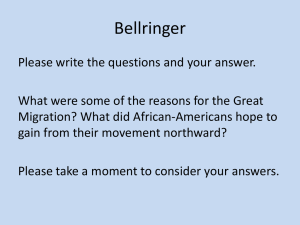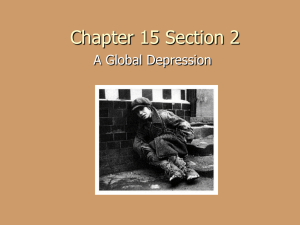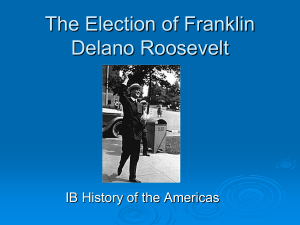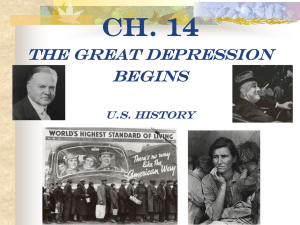08TAV Chapter 18 - Kearney Catholic Schools
advertisement
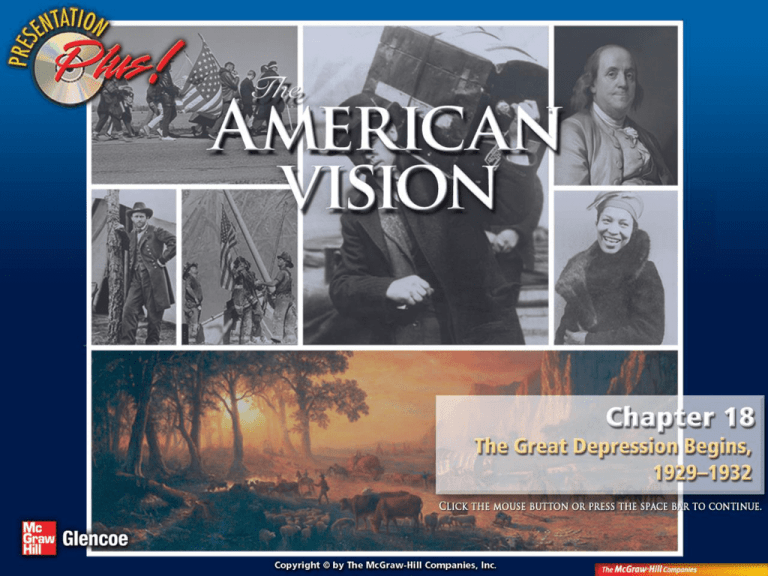
Chapter Introduction Section 1: The Causes of the Great Depression Section 2: Life During the Depression Section 3: Hoover Responds to the Depression Visual Summary What Causes Depressions? In the 1930s, the Great Depression caused high unemployment, business failures, and farm foreclosures. Many people lost their homes and savings and became willing to vote for politicians who offered new approaches to solving the crisis. • What kind of political and social problems do you think depressions cause? • Why do you think the Great Depression was worse than other economic slowdowns? The Causes of the Great Depression What factors led to the Great Depression? Life During the Depression How did people cope with life’s struggles during the Great Depression? Hoover Responds to the Depression How did Hoover’s policies attempt to lessen the Great Depression? Big Ideas Economics and Society Stock speculation on an unregulated stock market put investors and banks at risk in the 1920s. Content Vocabulary • stock market • speculation • bull market • bank run • margin • installment • margin call Academic Vocabulary • collapse • invest • sum People and Events to Identify • Alfred E. Smith • Black Tuesday • Hawley-Smoot Tariff Do you think that playing the stock market is too risky? A. Yes B. No A. A B. B 0% B A 0% The Long Bull Market A strong economy helped Herbert Hoover win the 1928 election, but increasing speculation in the stock market set the stage for a crash. The Long Bull Market (cont.) • Herbert Hoover, a Republican, and Alfred E. Smith, a Democrat, both ran for president in 1928. − Smith was the first Roman Catholic to win a majority party’s nomination for president. − Hoover defeated Smith, and promised a bright future for the country. Hoover and “Rugged Individualism” The Long Bull Market (cont.) • Sometimes the stock market experiences a long period of rising stock prices, or a bull market. • In the late 1920s a prolonged bull market convinced many people to invest in stocks. • As the market continued to soar, many investors began buying stocks on margin, making only a small cash down payment. The Long Bull Market (cont.) • To protect the loan, a broker could issue a margin call, demanding the investor repay the loan at once. • Buyers, hoping for a quick windfall, engaged in speculation. What was Smith’s biggest challenge during the election of 1928? A. Being a Roman Catholic B. Republicans taking credit for the nation’s prosperity C. His stance on taxes and the current economic situation 0% D. His past A A. B. C. 0% D. B A B C0% D C 0% D The Great Crash Rising stock process led to risky investment practices; when the stock market crashed, banks were in trouble. The Great Crash (cont.) • By the latter half of 1929, the market was running out of new customers. − In September, professional investors sensed danger and began to sell off their holdings. − Prices continued to fall. The Great Crash (cont.) • On October 24, a day that came to be called Black Thursday, the market plummeted further. − On October 29, a day that was later dubbed Black Tuesday, prices took the steepest dive yet. − By mid-November, stock prices had dropped by more than one-third. Stock Prices, 1920–1932 The Great Crash (cont.) • The market crash severely weakened the nation’s banks in two ways: − First, by 1929 banks had loaned nearly $6 billion to stock speculators. − Second, many banks had invested depositor’s money in the stock market, hoping for higher returns than they could get by using the money for loans. Bank Failures, 1928–1933 The Great Crash (cont.) • When the stock market collapsed, banks lost money on their investments, and speculators defaulted on their loans. − Many banks then cut back drastically on the loans they made. − Consumers and businesses were not able to borrow as much money. − This helped send the economy into a recession. Bank Failures, 1928–1933 The Great Crash (cont.) • More than 10 percent of the nation’s banks had closed by 1932. − If a bank collapsed, all customers lost their savings. − Some depositors made bank runs, causing the banks to collapse. Unemployment, 1928–1938 The stock market crash was the major cause of the Great Depression. A. Yes B. No A. A B. B 0% B A 0% The Roots of the Great Depression An uneven distribution of income, tariff policies, and the Federal Reserve Board’s mistakes contributed to the Great Depression. The Roots of the Great Depression (cont.) • The roots of the Great Depression were deeply entangled in the economy of the 1920s. • Most economist agree that overproduction was a key cause of the Great Depression. • Most Americans did not earn enough to buy up the flood of goods they helped produce. Causes of the Great Depression The Roots of the Great Depression (cont.) • During the 1920s, many Americans had purchased high-cost items on the installment plan. − Paying off such debts eventually forced some buyers to stop making new purchases. − Because of the decrease in sales, manufacturers in turn cut production and laid off employees. − A chain reaction ensued—when one company shut down, many others were affected. The Roots of the Great Depression (cont.) • Many jobs might have been saved if American manufacturers had sold more goods abroad. − The Hawley-Smoot Tariff raised the average tariff rate to the highest level in American history. − However, it failed to help American business because foreign countries responded by raising their own tariffs. − By 1932 exports were about one-fifth of what they had been in 1929. The Roots of the Great Depression (cont.) • Instead of raising interest rates to curb excessive speculation, the Federal Reserve Board kept its rates very low throughout the 1920s. • The Board’s failure to raise interest rates helped cause the Depression in two ways: − First, by keeping rates low, it encouraged member banks to make risky loans. The Roots of the Great Depression (cont.) − Second, its low interest rates led business leaders to think the economy was still expanding. • The Board made another mistake after the Depression hit—they raised interest rates, tightening credit. In 1929, the top 5 percent of all American households earned what percent of the nation’s income? A. 10 percent B. 30 percent C. 50 percent D. 70 percent 0% A A. B. C. 0% D. B A B C 0% D C 0% D Big Ideas Past and Present As the Great Depression and the drought worsened, thousands of people tried to find work and shelter in other places. Content Vocabulary • bailiff • hobo • soap opera Academic Vocabulary • suspend • colleague • technique People and Events to Identify • Dust Bowl • Walt Disney • John Steinbeck • William Faulkner • Grant Wood Can movies provide an escape from life? A. Yes B. No A. A B. B 0% B A 0% The Depression Worsens Hunger and homelessness became severe problems by the early 1930s; then, a terrible drought devastated the Great Plains. The Depression Worsens (cont.) • Throughout the country, newly homeless people put up shacks on unused or public lands, forming communities called shantytowns, or Hoovervilles. − Many had been thrown out of their homes by bailiffs. • In search of work or a better life, many hobos began to wander around the country. The Depression Worsens (cont.) • Farmers left many of their fields uncultivated due to a drop in crop prices. When a drought struck the Great Plains, the exposed soil turned to dust. • From the Dakotas to Texas, America’s wheat fields became a vast “Dust Bowl.” To where did most people from the Great Plains migrate in hopes of a better future? A. Mexico B. Canada C. California D. Florida 0% A A. B. C. 0% D. B A B C 0% D C 0% D Art and Entertainment Movies and radio shows were very popular during the 1930s, a period that also produced new art and literature. Art and Entertainment (cont.) • The hard times of the 1930s led many Americans to prefer entertainment that let them escape their worries. • In the late 1930s, the “superhero” genre was born with the printing of the first tales of Superman in 1938 and Batman in 1939. Art and Entertainment (cont.) • During the 1930s, more than 60 million Americans went to the movies each week. − Walt Disney produced the first featurelength animated film, Snow White and the Seven Dwarfs, in 1937. Art and Entertainment (cont.) • While movies captured the imagination, radio offered information and entertainment as near as the living room. − Radio dramas, nicknamed soap operas, also became popular. Art and Entertainment (cont.) • Writers and artists tried to portray life around them, using the homeless and unemployed as their subjects in stories and pictures. − John Steinbeck and William Faulkner were two influential novelists. Art and Entertainment (cont.) • Photographers roamed the nation with the new 35-millimeter cameras, seeking new subjects. − The striking pictures of photojournalists Dorothea Lange and Margaret BourkeWhite showed how the Great Depression had affected average Americans. • Painters in the 1930s included Thomas Hart Benton and Grant Wood, whose styles were referred to as the regionalist school. Which book did John Steinbeck write? A. The Sound and the Fury B. Huckleberry Finn C. The Grapes of Wrath D. The Scarlet Letter 0% A A. B. C. 0% D. B A B C 0% D C 0% D Big Ideas Government and Society President Hoover’s ideas about government shaped his response to the Great Depression, making the government slow to respond. Content Vocabulary • public works • relief • foreclose Academic Vocabulary • series • community People and Events to Identify • Reconstruction and Finance Corporation • Bonus Army Do you feel that the government should intervene immediately if the economy is struggling? A. Yes B. No A. A B. B 0% B A 0% Promoting Recovery Hoover encouraged businesses to stop laying off workers and created public works projects. Promoting Recovery (cont.) • Hoover tried to downplay the public’s fears, but his efforts failed to inspire the confidence of the American people. − He believed that the American system of “rugged individualism” would keep the economy moving. Promoting Recovery (cont.) • Hoover organized a series of conferences to devise strategies for improving the economy. − By 1931, industry leaders had broken their pledges to keep factories open and stop slashing wages. − He then increased the funding for public works, but these projects only created jobs for a small fraction of the millions who were unemployed. Promoting Recovery (cont.) • Hoover believed that government had to help banks make loans to corporations, which could then expand production and rehire workers. − In an attempt to ease the money shortage, Hoover set up the National Credit Corporation (NCC) in October 1931. − This program failed to meet the nation’s needs. Promoting Recovery (cont.) • In 1932, Hoover requested that Congress set up the Reconstruction Finance Corporation (RFC) to make loans to businesses. − The RFC was overly cautious, however, and failed to increase its lending sufficiently to meet the need. Promoting Recovery (cont.) • From the start, Hoover strongly opposed the federal government’s participation in relief. − He believed that only state and local governments should dole out relief. • However, in 1932, support for a federal relief measure increased, and Congress passed the Emergency Relief and Construction Act. − By this time, however, the new program could not reverse the accelerating collapse. Did Hoover believe that the government should step in to help people, or that the individual should help himself? A. Government A. A B. B A 0% 0% B B. Individual In An Angry Mood Farmers, veterans, and others who were suffering grew frustrated and demanded the government do something to help. In An Angry Mood (cont.) • Farmers and the hungry poor began to protest the conditions during the Depression. • Creditors foreclosed on nearly one million farms between 1930 and 1934, taking ownership of the land and evicting families. • In May 1932, several hundred Oregon veterans began marching to Washington to lobby for passage of the Wright Patman bill. − The press termed these marchers the “Bonus Army.” In An Angry Mood (cont.) • When the Senate voted down the bonus bill, veterans began to grumble. − General Douglas McArthur was put in charge of handling the situation. − National press coverage of troops assaulting veterans further harmed Hoover’s reputation and hounded the president throughout the 1932 campaign. Although Hoover failed to resolve the economic crises, what did he achieve? A. He gave the Supreme Court more power. B. He expanded the federal government’s economic role. C. He created confidence in the banking system. D. He inspired Americans to trust the government. 0% A A. B. C. 0% D. B A B C 0% D C 0% D Causes of the Depression Long-Range Causes • Uneven distribution of wealth ensures that many consumers do not have enough income to purchase the goods being produced. • Interest rates are kept too low by the Federal Reserve, which encourages businesses to borrow money and to expand production beyond market demand. • Overproduction by business eventually floods the market with goods that cannot be sold. Businesses begin laying off workers and shutting down production. Causes of the Depression Immediate Causes • People and businesses borrow money to invest in the stock market; speculation drives stock prices too high and when they collapse, many people lose all of their money, and many banks collapse when loans are not repaid. • As companies lay off workers, demand for goods falls as workers lack the income to purchase goods being produced. This in turn causes even more layoffs and a cyclical effect sets in, driving up unemployment. Causes of the Depression Immediate Causes • In order to protect American companies from competition, Congress raises tariffs. When other countries respond in kind, foreign demand for American goods falls, further hurting American companies. Effects of the Depression • Unemployment rises to record levels. • Many people, unable to pay their debts, lose their homes and farms; the homeless create shantytowns, nicknamed Hoovervilles, on the edges of cities. • Hunger marches, protests by farmers, and marches by veterans seeking their bonuses indicate growing anger among the population at economic conditions. Effects of the Depression • The Republican Party rapidly loses political support, enabling the Democrats to take control of Congress. • The federal government, for the first time, begins providing direct relief to citizens in need. • Forms of entertainment, including movies, radio shows, and comic books, focus on distracting people from their daily lives. Chapter Transparencies Menu Why It Matters Cause-and-Effect Transparency Unit Time Line Transparency Select a transparency to view. stock market a system for buying and selling stocks in corporations bull market a long period of rising stock prices margin buying a stock by paying only a fraction of the stock price and borrowing the rest margin call demand by a broker that investors pay back loans made for stocks purchased on margin speculation act of buying stocks at great risk with the anticipation that the price will rise bank run persistent and heavy demands from a bank’s depositors, creditors, or customers installment buying an item on credit with a monthly plan to pay off the value of the good collapse a sudden loss of force, value, or effect invest to put money into a company in order to gain a future financial reward sum a specified amount of money bailiff minor officer of the courts hobo a homeless and usually penniless wanderer soap opera a serial drama on television or radio using melodramatic situations suspend to temporarily stop an operation colleague a person who works in the same, or a similar, profession technique a method of achieving a desired task public works projects such as highways, parks, and libraries built with public funds for public use relief aid for the needy; welfare foreclose to take possession of a property from a mortgagor because of defaults on payments series a number of events that come one after another community people with common characteristics living in the same area To use this Presentation Plus! product: Click the Forward button to go to the next slide. Click the Previous button to return to the previous slide. Click the Home button to return to the Chapter Menu. Click the Transparency button from the Chapter Menu, Chapter Introduction, or Visual Summary slides to access the transparencies that are relevant to this chapter. From within a section, click on this button to access the relevant Daily Focus Skills Transparency. Click the Return button in a feature to return to the main presentation. Click the History Online button to access online textbook features. Click the Reference Atlas button to access the Interactive Reference Atlas. Click the Exit button or press the Escape key [Esc] to end the chapter slide show. Click the Help button to access this screen. Links to Presentation Plus! features such as Maps in Motion, Graphs in Motion, Charts in Motion, Concepts in Motion, and figures from your textbook are located at the bottom of relevant screens. This slide is intentionally blank.

